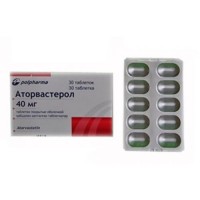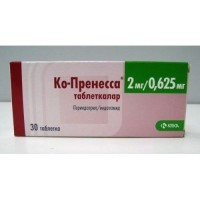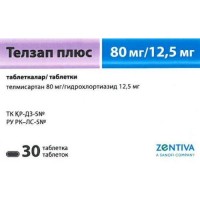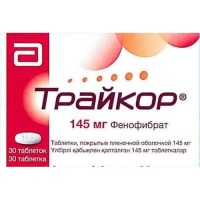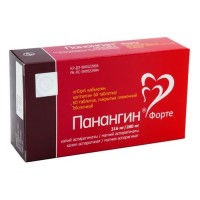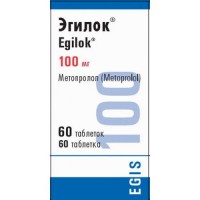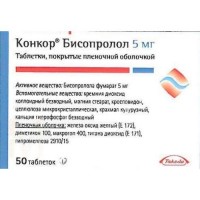Valodip 10 mg / 160 mg 28's film-coated tablets
- $29.00
Sku:
37f45f35894f
The instruction for medical use of Valodip Torgovoye medicine a name Valodip Mezhdunarodnoye the unlicensed name Is not present the Dosage form of the Tablet, film coated, 5 mg / 80 mg, 5 mg / 160 mg and 10 mg / 160 mg Structure One tablet contains For a dosage 5 mg / 80 mg: active agents: valsartan 80 mg, an amlodipina besilat 6.94 (it is equivalent to an amlodipin of 5 mg) For a dosage of 5 mg / 160 mg: active agents: valsartan 160 mg, an amlodipina besilat 6.94 (it is equivalent to an amlodipin of 5 mg) For a dosage of 10 mg / 160 mg: active agents: valsartan 160 mg, an amlodipina besilat 13.88 (it is equivalent amlodipinu10 to mg) excipients: microcrystalline cellulose, magnesium Mannitolum stearate, sodium of a kroskarmelloz, povidone, silicon dioxide colloidal anhydrous, sodium lauryl sulfate film cover: Opadray II white (consists of the polyvinyl alcohol which is partially hydrolyzed, the titan of dioxide (E171), a macrogoal and talc), ferrous oxide yellow (E172) the Description of the Tablet of round shape, film coated brownish-yellow color, slightly biconvex, with a facet and possible dark stains (for a dosage of 5 mg / 80 mg). Tablets of an oval form, film coated brownish-yellow color, biconvex, with possible dark stains (for a dosage of 5 mg / 160 mg). Tablets of an oval form, film coated brownish-yellow color, biconvex (for a dosage of 10 mg / 160 mg) Pharmacotherapeutic group of Angiotensin II antagonists in a combination with other drugs. Antagonists of angiotensin ІІ and blockers of calcium channels. Valsartan and amlodipin. The ATX C09D B01 code the Pharmacological Pharmacokinetics Pharmacokinetics properties of the drug Valodip® is characterized by linearity. As pharmacokinetic interaction between valsartany and amlodipiny is absent, the pharmacokinetics for each drug separately is given below. Amlodipin Posle of intake of an amlodipin in therapeutic doses the maximum concentration of an amlodipin in blood plasma is reached in 6-12 hours. Values of absolute bioavailability by calculations are between 64% and 80%. Meal does not affect bioavailability of an amlodipin. The volume of distribution is about 21 l/kg. 97.5 the % of the circulating drug contacts proteins of plasma. Amlodipin intensively (90%) is metabolized in a liver with formation of active metabolites. Removal of an amlodipin from plasma has two-phase character with terminal elimination half-life from 30 to 50 hours. Equilibrium concentration in plasma are reached after long use within 7-8 days. Ten percent of not changed amlodipin and 60% of an amlodipin in the form of metabolites are removed with urine. Valsartan Posle of intake of one valsartan the maximum concentration of a valsartan is reached in 2-3 hours. The average absolute bioavailability is 23%. Valsartan has the multiexponential nature of parameters of removal (t1/2α & lt, 1 h and t1/2ß about 9 h). Food reduces bioavailability (on AUC value) for 40% and the maximum concentration in blood plasma (Cmax) honor a valsartan for 50% though almost in 8 h after reception of concentration of a valsartan in blood plasma are identical as in at meal, and on an empty stomach. This reduction of AUC, however, is not followed by clinically significant reduction of therapeutic effect, valsartan, thus, it is possible to appoint or with meal or on an empty stomach. In an equilibrium state the volume of distribution of a valsartan after intravenous administration is 17 l that ukazyvt on lack of extensive distribution of a valsartan in fabric. Valsartan highly contacts proteins of serum (94-97%), mainly serum albumine. Valsartan is not exposed to the significant metabolism since only about 20% of a dose are defined in the form of metabolites. The hydroxyl metabolite is identified in plasma in low concentration (less than 10% of AUC of a valsartan). This metabolite pharmacological is active. Vasartan is brought generally in not changed view with a stake (about 83% of a dose) and, generally in not changed view with urine (about 13% of a dose). After intravenous administration, the plasma clearance of a valsartan is about 2 l/h and its renal clearance is 0.62 l/h (about 30% of the general clearance). Elimination half-life of a valsartan makes 6 hours. A combination of the fixed doses amlodipin/valsartan After intake of a combination of the fixed doses amlodipin/valsartan the maximum concentration of a valsartan and amlodipin are reached in 3 and 6-8 hours, respectively. Speed and extent of absorption of a combination of the fixed doses amlodipin/valsartan are equivalent to bioavailability of a valsartan and an amlodipin at reception of each of them separately. The pharmacodynamics of Valodip® is a combination of two antihypertensive substances with the mechanism of control of arterial blood pressure supplementing each other at patients with essential hypertensia: amlodipin belongs to the class of antagonists of calcium and valsartan to a class of drugs of antagonists of angiotensin II. The combination of these ingredients has additive antihypertensive effect, reducing arterial blood pressure more than each component separately. Amlodipin who is a part of the drug Valodip® inhibits transmembrane receipt of calcium ions in cardiac and vascular smooth muscles. The mechanism of antihypertensive action of an amlodipin is caused by the direct relaxing action on smooth muscles of vessels that leads to decrease in peripheric vascular resistance and arterial blood pressure. After introduction of therapeutic doses for patients with a hypertension, amlodipin causes vasodilatation and leads to a lowering of arterial pressure in a lying state and in a standing position. These is not followed a lowering of arterial pressure by a significant change in heart rate or level of catecholamines in blood at constant use. At patients with an arterial hypertension with normal function of kidneys, amlodipin in therapeutic doses leads to decrease in renal vascular resistance and increase in glomerular filtration rate and an effective renal blood-groove of plasma without changes of filtration or a proteinuria. As well as other blockers of calcium channels, measurement of parameters of a hemodynamics and function of heart at rest, at physical activity (or walking) at patients with normal function of the ventricles receiving amlodipin in general showed small increase in cardiac index without significant effect on end diastolic pressure or volume. Amlodipin does not change function of sinus node or atrioventricular conductivity at intact animals or people. Valsartan is a peroral active, strong and specific antagonist of receptors of angiotensin II. It acts selectively on AT1 a subtype of a receptor which is responsible for activity of angiotensin II. Plasma angiotensin II after blockade of AT1 receptors valsartany the unblocked AT2-receptors which appear for equilibration of effect of receptors of AT1 can stimulate the increased level. Valsartan is not partial agonist of activity of AT 1 of receptors and has high (about 20000 times) bigger affinity to AT 1 to receptors, than for AT2 of receptors. Valsartan does not inhibit APF known also as kininaz of II who turns angiotensin I into angiotensin II and reduces bradykinin level. At administration of drug of Valodip® in a single dose the hypotensive effect remains during 24 h. Sudden drug withdrawal of Valodip® is not followed by fast increase in arterial blood pressure. At patients at whom arterial blood pressure was adequately controlled amlodipiny, but extremely profound hypostasis was observed, at combination therapy the same control of arterial blood pressure was reached with less profound hypostasis. Age, sex and race do not affect efficiency of the drug Valodip®. Indications - treatment of essential hypertensia at inefficiency of monotherapy the Route of administration and doses Patients at whom arterial blood pressure does not give in to adequate control at use only of one amlodipin (or other blocker of calcium channels of derivative dihydropyridine) or only one valsartan (or other blocker of retsepotor of angiotensin II) can be transferred to combination therapy by the drug Valodip®. The recommended dose - 1 tablet a day (5 mg of an amlodipn and 80 mg of a valsartan or 5 mg of an amlodipin and 160 mg of a valsartan, or 10 mg of an amlodipin and 160 mg of a valsartan). At clinical compliance the direct transition from monotherapy to a combination with the fixed dose can be considered. For initial therapy the usual starting dose makes 5 mg / 80 mg once a day. The dosage can be increased in 1 – 2 weeks to the maximum dose of 10 mg / 320 by mg once a day as required for control of arterial blood pressure. Валодип® it is not recommended as initial therapy at patients with deficit of volume of the circulating blood. The maximum daily dose makes 10 mg / 320 mg. For convenience, the patients receiving valsartan and amlodipin in separate tablets can be transferred to Valodip® containing these components in the same doses. Валодип® it is possible to accept with food or irrespective of meal with a small amount of water. Side effects the side Below-mentioned reactions are classified by bodies, systems and frequency of emergence, and the most widespread are specified the first. For each frequency in group the side reactions are located in ascending order of gravity. Often (& gt, 1/100, & lt, 1/10) a nasopharyngitis, grippopodobny symptoms a headache hypostases, a face edema, pastosity, hypostasis of the lower extremities, fatigue, "hot" inflows, an asthenia Infrequently (& gt, 1/1000, & lt, 1/100) dizziness, drowsiness, postural dizziness, paresthesia vertigo tachycardia, a cardiopalmus orthostatic hypotension cough, a sore throat and throats diarrhea, nausea, abdominal pain, a constipation, dryness in a mouth rash, an erythema a swelling of joints, a dorsodynia, an artalgiya Seldom (& gt, 1/10000, & lt, 1/1000) hypersensitivity a disorder of vision uneasiness sonitus a syncope arterial hypotension a hyperhidrosis, a dieback, an itching muscular spasms, heavy feeling a pollakiuria, a polyuria disturbance of erectile function increase in level of urea Additional information concerning the Valodip® components can cause the side reactions which are earlier noted for one of individual components even if such reactions were not observed in clinical trials. Amlodipin Sleduyushchiye additional side reactions were noted in clinical trials at monotherapy amlodipiny, irrespective of relationship of cause and effect with the studied drug. Infrequently: doubling in eyes, insomnia, changes of mood, a tremor, a hypesthesia, a dysgeusia, an asthma, rhinitis, vomiting, dyspepsia, an alopecia, a purpura, disturbance of coloring of skin, photosensitivity, myalgia, urination disorder, a nocturia, a gynecomastia, pain, an indisposition, a stethalgia, increase or weight reduction. Very seldom: thrombocytopenia, a leukopenia, allergic reactions, a hyperglycemia, a hypertension, peripheral neuropathy, arrhythmia, bradycardia, ventricular tachycardia, atrial fibrillation, a myocardial infarction, a vasculitis, pancreatitis, gastritis, a hyperplasia of gums, hepatitis, jaundice, a Quincke's disease, a small tortoiseshell, a multiformny erythema, Stephens-Johnson's syndrome, increase in level of liver enzymes (most often connected with a cholestasia). Valsartan the Side effects gained as a result of post-market and laboratory researches (it is impossible to classify by frequency): - - a neutropenia, thrombocytopenia - hypersensitivity, including a serum disease, a Quincke's disease - increase in potassium concentration in blood serum - a vasculitis - increase in indicators of function of a liver, including increase in serumal bilirubin - myalgia - deterioration in function of kidneys - increase in level of serumal creatinine the Following additional by-effects noted decrease in hemoglobin, decrease in a hematocrit in clinical trials at monotherapy valsartany, irrespective of relationship of cause and effect with the studied drug: - insomnia, decrease in a libido - pharyngitis, rhinitis, sinusitis, upper respiratory tract infections - viral infections of the Contraindication hypersensitivity to active agent or to any of auxiliary components a heavy renal failure (clearance of creatinine & lt, 30 ml/min.), an anury and patients the heavy abnormal liver functions which are on dialysis a Quincke's disease in the anamnesis of consequences of use of APF inhibitors, biliary cirrhosis, a cholestasia the profound arterial hypotension pregnancy and the period of a lactation children's and teenage age up to 18 years simultaneous use of antagonists of receptors of angiotensin, including a valsartan, or inhibitors of the angiotensin-converting enzyme (ACE) with aliskireny at patients with diabetes ІІ type shock (including karidiogenny shock) obstruction of the taking-out path of a left ventricle (for example, a hypertrophic subaortic stenosis and the profound aortal stenosis) hemodynamically unstable heart failure after an acute myocardial infarction Medicinal interactions Other antihypertensive drugs Often used antihypertensive drugs (for example, alpha blockers, diuretics) and other medicines which can cause hypotension as side effect (for example, tricyclic antidepressants, alpha blockers for treatment of a benign hyperplasia of a prostate) can increase antihypertensive effect of this combination. Amlodipin Simvastatin: simultaneous use of repeated doses of 10 mg of an amlodipin and 80 mg of a simvastatin led to increase in exposure of a simvastatin by 77% in comparison with use of one simvastatin. It is recommended to limit a dose of a simvastatin to 20 mg a day at the patients accepting amlodipin. Grapefruit or juice of grapefruit Use of an amlodipin with grapefruit or grapefruit juice is not recommended as at some patients the decrease in effect on the increased arterial blood pressure can be observed. CYP3A4 inhibitors: and 5 mg of an amlodipin at elderly patients with a hypertension led a concomitant use of a daily dose of 180 mg of diltiazem to increase in system exposure of an amlodipin by 1.6 times. Nevertheless, strong CYP3A4 inhibitors (for example, ketokonazol, itrakonazol, ritonavir) can increase concentration of an amlodipin in blood plasma more than diltiazem. Therefore it is necessary to show care at combined use of an amlodipin with CYP3A4 inhibitors. Inductors CYP3A4: there is no available information on quantitative effects of the inductors CYP3A4 concerning an amlodipin. Patsiyentov it is necessary to control rather adequate clinical effect at simultaneous use of an amlodipin with the inductors CYP3A4. At monotherapy amlodipiny clinically significant medicinal interactions with the following drugs are not established: thiazide diuretics, beta-blockers, APF inhibitors, nitrates of long action, sublingual nitroglycerine, digoxin, warfarin, atorvastatin, sildenafit, maaloks (hydroxide aluminum gel, magnesium hydroxide, simetikon), Cimetidinum, NPVS, antibiotics, oral hypoglycemic means. Dantrolen (infusion): deadly fibrillation of ventricles and cardiovascular collapse were observed at animals along with a hyperpotassemia after simultaneous administration of verapamil and an intravenous dantrolen. Because of risk of a hyperpotassemia it is recommended to avoid joint introduction of blockers of calcium channels, such as amlodipin, at the patients sensitive to a malignant hyperthermia and for management of a malignant hyperthermia. Valsartan Lity It was reported about reverse increase in concentration of lithium in serum and toxicity at simultaneous use of lithium with angiotensin-converting enzyme or the antagonist of a receptor of angiotensin II, including valsartany. Therefore careful monitoring of concentration of lithium in serum is recommended during simultaneous use. If also diuretic is used, the risk of toxicity of lithium can be increased presumably at a concomitant use of Valodipa®. Double blockade system renin-angiotenzinovoy (SRA) antagonists of receptors of angiotensin, APF inhibitors or aliskireny: simultaneous use of antagonists of receptors of angiotensin,
including a valsartan, with other substances operating on SRA is connected with increase in quantity of cases of hypotensions, hyperpotassemias, and changes in function of kidneys in comparison with monotherapy. It is recommended to control arterial blood pressure, function of kidneys and level of electrolytes at patients of applying Valodip® and other substances influencing SRA. It is necessary to avoid simultaneous use of antagonists of receptors of angiotensin, including a valsartan, or APF inhibitors with aliskireny, at patients with a heavy renal failure (SKF & lt, 30 ml/min.). Simultaneous use of antagonists of receptors of angiotensin, including a valsartan, or APF inhibitors with aliskireny is contraindicated at patients with diabetes 2 types. Potassium: simultaneous use with potassium additives, kaliysberegayushchy diuretics, salt substitutes which contain potassium or other drugs which can increase potassium level (heparin, etc.) demands care. It is necessary to provide frequent control of level of content of potassium. Non-steroidal anti-inflammatory drugs (NPVS), including selection inhibitors of cyclooxygenase-2 (TsOG-2 inhibitors): at simultaneous use of antagonists of angiotensin II with NPVS the easing of antihypertensive effect can take place. Besides, at patients of advanced age with a reduced volume of liquid (including at patients on therapy by diuretics) or with komprometirovanny function of kidneys the simultaneous use of antagonists of angiotensin II and NPVS can result in the increased risk of deterioration in function of kidneys. Thus, it is recommended to carry out control of function of kidneys at the beginning or at change of treatment of patients valsartany, NPVS accepting at the same time. Conveyors: valsartan is substrate of the conveyor of hepatic capture OATP1B1 and substrate of the conveyor of hepatic outflow of MRP2. Co-administration of inhibitors of the conveyor of capture (rifampicin, cyclosporine) or the outflow conveyor (ritonavir) can increase system influence of a valsartan. At monotherapy valsartany clinically significant medicinal interactions with the following drugs are not established: Cimetidinum, warfarin, furosemide, digoxin, atenolol, indometacin, hydrochlorothiazide, amlodipin, glibenclamide. Special instructions Patients with deficiency of sodium and/or reduction VCB (the volume of the circulating blood) At patients with uncomplicated hypertensia the excessive hypotension was observed. At patients with the system activated renin-angiotensin-aldosteronovoy (in such cases as deficit of OCK and/or salts at the patients receiving diuretics in high doses) who receive blockers of angiotenzinovy receptors, development of symptomatic arterial hypotension is possible. Correction of this state before purpose of Valodipa® or careful medical observation at the beginning of therapy is recommended. If at reception of Valodipa® the hypotension is observed, then the patient should be placed in horizontal position, if necessary to appoint intravenous infusion of normal saline solution. Treatment should be continued until stabilization of arterial blood pressure. The hyperpotassemia At simultaneous use with the dietary supplements containing potassium, kaliysberegayushchy diuretics, kaliysoderzhashchy substitutes of salt, or with other drugs which can cause increase in potassium concentration in blood (for example, with heparin) is required care and frequent definition of potassium concentration in blood. The renal artery stenosis of Valodip® has to be applied with care to treatment of hypertensia at patients with a unilateral or bilateral renal artery stenosis, a stenosis of the only kidney in a type of possible increase in level of urea and creatinine in blood plasma at such patients. The renal failure from easy to moderate extent of dose adjustment of Valodipa® is not required to Patients with renal failures. It is necessary to avoid simultaneous use of antagonists of receptors of angiotensin, including a valsartan, or APF inhibitors with aliskireny at patients with a heavy renal failure (SKF & lt, 30 ml/min.). Transplantation of a kidney Experience of safe use of Valodipa® for patients from the kidney which is recently postponed transplantation is absent. Abnormal liver functions Extra care should be observed when assigning Valodipa® to patients with diseases of a liver and obstructive diseases of bilious ways. A Quincke's disease there Are messages about the Quincke's disease including edema of laryngeal and glottis, the airways leading to obstruction and/or to edema of face, lips, drinks and/or language at the patients accepting valsartan. In the anamnesis of some of these patients there is an instruction on development of the Quincke's disease caused by other drugs, including APF inhibitors. Валодип® patients at whom the Quincke's disease develops need to cancel immediately, and it is not necessary to appoint this drug repeatedly. Patients with heart failure / after the postponed myocardial infarction in general, blockers of calcium channels, including amlodipin, should be used with care at patients with serious stagnant heart failure (functional class III-IV on classification of the New York cardiological association (NYHA)). At patients whose function of kidneys can depend on activity of a system renin-angiotensin-Aldosteronum (for example, patients with heavy stagnant heart failure), treatment by inhibitors of angiotensin-converting enzyme or antagonists of receptors of angiotensin it was connected with an oliguria and/or with a progressive azotemia and, in rare instances, with an acute renal failure and/or with death. Assessment of patients with heart failure or after the postponed myocardial infarction has to include definition of function of kidneys always. Patients with an acute myocardial infarction. Deterioration in stenocardia and an acute myocardial infarction can develop after reception of an initial dose of an amlodipin or its increase, especially at patients with a serious obstructive illness of a coronary artery. A stenosis of aortal and mitral valves, a subaortic hypertrophic stenosis the Extra care is shown for the patients having an aortal or mitral stenosis, or a subaortic hypertrophic stenosis. Double blockade renin-angiotenzinovoy of a system Ras Odnovremennoye use of the blockers renin-angiotensin (BRA), including a valsartana, with other means influencing RAAS is connected with increase in number of cases of hypotonia, a hyperpotassemia and a renal failure in comparison with monotherapy. Therefore it is recommended to control the blood pressure, function of kidneys and level of electrolytes at the patients accepting Valodip® and other drugs which influence RAAS. The care is necessary at joint introduction of BRA - including a valsartana – with other drugs blocking RAAS, such as APF inhibitors or aliskiren. Simultaneous use of BRA - including a valsartan or APF inhibitor of an aliskiren - at patients with diabetes or a renal failure (SKF & lt, 60ml/minn/1.73 sq.m) is contraindicated (see the section "Contraindications"). The liver failure Valsartan, is generally removed without changes, with bile. The half-life period of an amlodipin increases and AUC is higher at patients with abnormal liver functions, recommendations about dosing are not established. It is necessary to show care when assigning Valodip® to patients with easy or moderate degree of an abnormal liver function or with obstruction of bile ducts. At patients with a slight and moderate liver failure without cholestasia, the maximum recommended dose makes 80 mg of a valsartan. Pregnancy and a lactation of Valodip® it should not be appointed to women who plan pregnancy. The doctor has to warn the woman about potential risk when assigning Valodipa® at pregnancy. If in the course of therapy the pregnancy is established, administration of drug needs to be stopped immediately. The feature of influence of medicine on ability to run motor transport or other potentially dangerous mechanisms Is recommended to be careful during the driving of the car and control of mechanisms. Overdose Symptoms: the profound hypotension with dizziness and also the accruing perefirichesky vazodilatation and reflex tachycardia. It was reported about the considerable and potentially prolonged system hypotension, up to shock and a fatal outcome. Treatment: if administration of drug happened recently, it is necessary to cause vomiting or to carry out gastric lavage. Absorption of Valodipa® considerably decreases when using activated carbon at once or for 2 hours after reception. Clinically significant arterial hypotension caused by overdose of Valodipa® demands active support of a condition of a cardiovascular system, including constant control of warm and respiratory function, raising of extremities and attention to the volume of the circulating liquid and urination. For restoration of a vascular tone and blood pressure there can be useful a vasoconstrictor, when accounting lack of contraindications for its use. For lifting the siege of calcium channels there can be reasonable an intravenous administration of calcium of a gluconate. The form of release and packing On 7 (for dosages of 5 mg / 160 mg and 10 mg / 160 mg) or 14 (for a dosage of 5 mg / 80 mg) tablets place in blister strip packaging from a film of the laminated polyamide/aluminium/polyvinylchloride and aluminum foil. On 2 (for a dosage of 5 mg / 80 mg) or 4 (for dosages of 5 mg / 160 mg and 10 mg / 160 mg) blister strip packagings together with the instruction for medical use in the state and Russian languages Storage conditions place in a pack from cardboard to Store at a temperature not over 30 ºС. To store out of children's reach! 3 years not to use a period of storage after an expiration date. Prescription status According to the prescription LLC KRKA-RUS Producer, Russia Moskovskaya St., 50, 143500, Istra, the Moscow region the Owner of the registration certificate of KRK, of, the Place Is new, Slovenia
to Develop the Address of the organization accepting in the territory of the Republic of Kazakhstan claims from consumers on quality of products (goods) of KRKA Kazakhstan LLP RK, 050059, Almaty, Al-Farabi Ave. 19, body 1, the 2nd floor
including a valsartan, with other substances operating on SRA is connected with increase in quantity of cases of hypotensions, hyperpotassemias, and changes in function of kidneys in comparison with monotherapy. It is recommended to control arterial blood pressure, function of kidneys and level of electrolytes at patients of applying Valodip® and other substances influencing SRA. It is necessary to avoid simultaneous use of antagonists of receptors of angiotensin, including a valsartan, or APF inhibitors with aliskireny, at patients with a heavy renal failure (SKF & lt, 30 ml/min.). Simultaneous use of antagonists of receptors of angiotensin, including a valsartan, or APF inhibitors with aliskireny is contraindicated at patients with diabetes 2 types. Potassium: simultaneous use with potassium additives, kaliysberegayushchy diuretics, salt substitutes which contain potassium or other drugs which can increase potassium level (heparin, etc.) demands care. It is necessary to provide frequent control of level of content of potassium. Non-steroidal anti-inflammatory drugs (NPVS), including selection inhibitors of cyclooxygenase-2 (TsOG-2 inhibitors): at simultaneous use of antagonists of angiotensin II with NPVS the easing of antihypertensive effect can take place. Besides, at patients of advanced age with a reduced volume of liquid (including at patients on therapy by diuretics) or with komprometirovanny function of kidneys the simultaneous use of antagonists of angiotensin II and NPVS can result in the increased risk of deterioration in function of kidneys. Thus, it is recommended to carry out control of function of kidneys at the beginning or at change of treatment of patients valsartany, NPVS accepting at the same time. Conveyors: valsartan is substrate of the conveyor of hepatic capture OATP1B1 and substrate of the conveyor of hepatic outflow of MRP2. Co-administration of inhibitors of the conveyor of capture (rifampicin, cyclosporine) or the outflow conveyor (ritonavir) can increase system influence of a valsartan. At monotherapy valsartany clinically significant medicinal interactions with the following drugs are not established: Cimetidinum, warfarin, furosemide, digoxin, atenolol, indometacin, hydrochlorothiazide, amlodipin, glibenclamide. Special instructions Patients with deficiency of sodium and/or reduction VCB (the volume of the circulating blood) At patients with uncomplicated hypertensia the excessive hypotension was observed. At patients with the system activated renin-angiotensin-aldosteronovoy (in such cases as deficit of OCK and/or salts at the patients receiving diuretics in high doses) who receive blockers of angiotenzinovy receptors, development of symptomatic arterial hypotension is possible. Correction of this state before purpose of Valodipa® or careful medical observation at the beginning of therapy is recommended. If at reception of Valodipa® the hypotension is observed, then the patient should be placed in horizontal position, if necessary to appoint intravenous infusion of normal saline solution. Treatment should be continued until stabilization of arterial blood pressure. The hyperpotassemia At simultaneous use with the dietary supplements containing potassium, kaliysberegayushchy diuretics, kaliysoderzhashchy substitutes of salt, or with other drugs which can cause increase in potassium concentration in blood (for example, with heparin) is required care and frequent definition of potassium concentration in blood. The renal artery stenosis of Valodip® has to be applied with care to treatment of hypertensia at patients with a unilateral or bilateral renal artery stenosis, a stenosis of the only kidney in a type of possible increase in level of urea and creatinine in blood plasma at such patients. The renal failure from easy to moderate extent of dose adjustment of Valodipa® is not required to Patients with renal failures. It is necessary to avoid simultaneous use of antagonists of receptors of angiotensin, including a valsartan, or APF inhibitors with aliskireny at patients with a heavy renal failure (SKF & lt, 30 ml/min.). Transplantation of a kidney Experience of safe use of Valodipa® for patients from the kidney which is recently postponed transplantation is absent. Abnormal liver functions Extra care should be observed when assigning Valodipa® to patients with diseases of a liver and obstructive diseases of bilious ways. A Quincke's disease there Are messages about the Quincke's disease including edema of laryngeal and glottis, the airways leading to obstruction and/or to edema of face, lips, drinks and/or language at the patients accepting valsartan. In the anamnesis of some of these patients there is an instruction on development of the Quincke's disease caused by other drugs, including APF inhibitors. Валодип® patients at whom the Quincke's disease develops need to cancel immediately, and it is not necessary to appoint this drug repeatedly. Patients with heart failure / after the postponed myocardial infarction in general, blockers of calcium channels, including amlodipin, should be used with care at patients with serious stagnant heart failure (functional class III-IV on classification of the New York cardiological association (NYHA)). At patients whose function of kidneys can depend on activity of a system renin-angiotensin-Aldosteronum (for example, patients with heavy stagnant heart failure), treatment by inhibitors of angiotensin-converting enzyme or antagonists of receptors of angiotensin it was connected with an oliguria and/or with a progressive azotemia and, in rare instances, with an acute renal failure and/or with death. Assessment of patients with heart failure or after the postponed myocardial infarction has to include definition of function of kidneys always. Patients with an acute myocardial infarction. Deterioration in stenocardia and an acute myocardial infarction can develop after reception of an initial dose of an amlodipin or its increase, especially at patients with a serious obstructive illness of a coronary artery. A stenosis of aortal and mitral valves, a subaortic hypertrophic stenosis the Extra care is shown for the patients having an aortal or mitral stenosis, or a subaortic hypertrophic stenosis. Double blockade renin-angiotenzinovoy of a system Ras Odnovremennoye use of the blockers renin-angiotensin (BRA), including a valsartana, with other means influencing RAAS is connected with increase in number of cases of hypotonia, a hyperpotassemia and a renal failure in comparison with monotherapy. Therefore it is recommended to control the blood pressure, function of kidneys and level of electrolytes at the patients accepting Valodip® and other drugs which influence RAAS. The care is necessary at joint introduction of BRA - including a valsartana – with other drugs blocking RAAS, such as APF inhibitors or aliskiren. Simultaneous use of BRA - including a valsartan or APF inhibitor of an aliskiren - at patients with diabetes or a renal failure (SKF & lt, 60ml/minn/1.73 sq.m) is contraindicated (see the section "Contraindications"). The liver failure Valsartan, is generally removed without changes, with bile. The half-life period of an amlodipin increases and AUC is higher at patients with abnormal liver functions, recommendations about dosing are not established. It is necessary to show care when assigning Valodip® to patients with easy or moderate degree of an abnormal liver function or with obstruction of bile ducts. At patients with a slight and moderate liver failure without cholestasia, the maximum recommended dose makes 80 mg of a valsartan. Pregnancy and a lactation of Valodip® it should not be appointed to women who plan pregnancy. The doctor has to warn the woman about potential risk when assigning Valodipa® at pregnancy. If in the course of therapy the pregnancy is established, administration of drug needs to be stopped immediately. The feature of influence of medicine on ability to run motor transport or other potentially dangerous mechanisms Is recommended to be careful during the driving of the car and control of mechanisms. Overdose Symptoms: the profound hypotension with dizziness and also the accruing perefirichesky vazodilatation and reflex tachycardia. It was reported about the considerable and potentially prolonged system hypotension, up to shock and a fatal outcome. Treatment: if administration of drug happened recently, it is necessary to cause vomiting or to carry out gastric lavage. Absorption of Valodipa® considerably decreases when using activated carbon at once or for 2 hours after reception. Clinically significant arterial hypotension caused by overdose of Valodipa® demands active support of a condition of a cardiovascular system, including constant control of warm and respiratory function, raising of extremities and attention to the volume of the circulating liquid and urination. For restoration of a vascular tone and blood pressure there can be useful a vasoconstrictor, when accounting lack of contraindications for its use. For lifting the siege of calcium channels there can be reasonable an intravenous administration of calcium of a gluconate. The form of release and packing On 7 (for dosages of 5 mg / 160 mg and 10 mg / 160 mg) or 14 (for a dosage of 5 mg / 80 mg) tablets place in blister strip packaging from a film of the laminated polyamide/aluminium/polyvinylchloride and aluminum foil. On 2 (for a dosage of 5 mg / 80 mg) or 4 (for dosages of 5 mg / 160 mg and 10 mg / 160 mg) blister strip packagings together with the instruction for medical use in the state and Russian languages Storage conditions place in a pack from cardboard to Store at a temperature not over 30 ºС. To store out of children's reach! 3 years not to use a period of storage after an expiration date. Prescription status According to the prescription LLC KRKA-RUS Producer, Russia Moskovskaya St., 50, 143500, Istra, the Moscow region the Owner of the registration certificate of KRK, of, the Place Is new, Slovenia
to Develop the Address of the organization accepting in the territory of the Republic of Kazakhstan claims from consumers on quality of products (goods) of KRKA Kazakhstan LLP RK, 050059, Almaty, Al-Farabi Ave. 19, body 1, the 2nd floor

